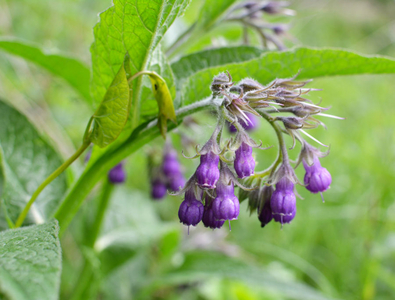Utilisation

Today, preparations made from comfrey root(Symphyti radix), consisting of the fresh or dried underground parts, are predominantly used. Occasionally, the above-ground parts of the plant (comfrey herb and comfrey leaves) are used. They contain mucilage, allantoin, tannins, rosmarinic acid and choline.
From today's perspective, only their external use is medically recognised. Clinical studies have confirmed its successful use for painful muscle and joint complaints, strains, bruises and sprains (after the acute phase has subsided) as well as its effect in promoting blood circulation. The plant is also said to be helpful for tendonitis and joint arthrosis.
For external use, a fluid extract of comfrey root is usually processed into ointments, gels and poultices, sometimes in combination with other pharmaceutical plant drugs.
The wound- and joint-healing effect is primarily attributed to allantoin, which promotes the formation of new bone tissue, cell renewal and tissue regeneration.
Botany
Comfrey or medicinal comfrey belongs to the family Boraginaceae. The perennial plant can grow up to 1 metre tall with its winged, rough-haired stem. Its leaves are broadest in the centre, elongated and pointed, also rough-haired and arranged alternately on the stem. At the top, the leaves narrow and run far down the stem.
The tubular, bell-shaped, nodding flowers are usually purple-violet, more rarely yellow or white, and have inner pharyngeal scales. They are clustered together in double vines in the upper leaf axils. Flowering time is from May to July, sometimes even into September. The thick, fleshy root helps the plant to survive the cold season.
Distribution
Around 35 different Symphytum species are known worldwide, eleven of which are native to Europe. Six of them can be found in Austria. Comfrey prefers to grow in sunny to semi-shady, moist, nutrient-rich locations such as wet meadows, riparian meadows, ditches and alluvial forests, especially on clay soils. It is common to scattered throughout Austria up to altitudes of 1,000 metres.
Service
The preservation of diversity is very important to us, which is why we store around 5,400 samples of seeds and plants in our gene bank. With the gene bank for agricultural crops, medicinal and aromatic plants, we are making a significant contribution to the preservation of biodiversity.
Last updated: 12.07.2024
automatically translated